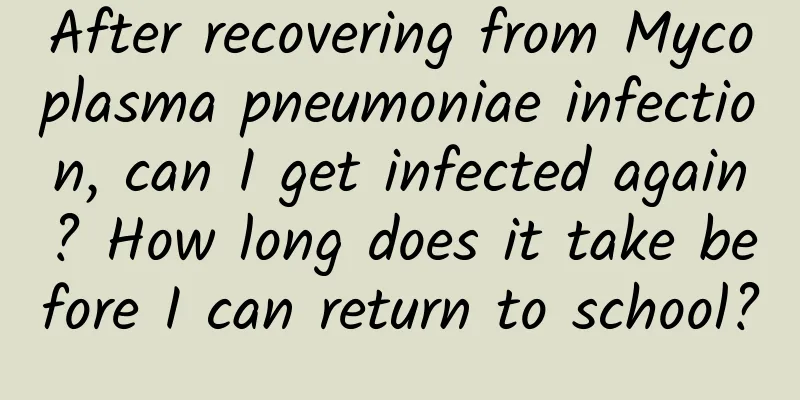After recovering from Mycoplasma pneumoniae infection, can I get infected again? How long does it take before I can return to school?

|
When the baby coughs, the parents tremble! "Mycoplasma pneumoniae" has attracted much attention recently. In response to parents' questions, this article has compiled a list of answers. Let's take a look! 1. What is Mycoplasma pneumoniae infection ? Is it contagious? Mycoplasma pneumoniae is a microorganism between viruses and bacteria and is a common pathogen in nature. Mycoplasma pneumoniae has no cell wall structure, like a bacterium without a "coat". 75% alcohol and chlorine-containing disinfectants (such as 84 disinfectant) can kill Mycoplasma pneumoniae. The population is generally susceptible to Mycoplasma pneumoniae. The proportion of pneumonia after infection in children aged 5 years and above is higher than that in other groups. Children under 5 years old and adults may also become ill. The disease is contagious to a certain extent. Mycoplasma pneumoniae is mainly transmitted through respiratory droplets , and the pathogen can be carried in sputum, secretions from coughing, sneezing, and runny nose. Patients infected with Mycoplasma pneumoniae and asymptomatic carriers are the main sources of infection. Symptoms in adults after infection are generally mild, with respiratory symptoms such as cough being common, and usually responding well to treatment with antibacterial drugs such as macrolides or quinolones. Because children's immune systems are not yet fully developed, their symptoms after infection with Mycoplasma pneumoniae are more severe than those of adults . They are generally characterized by fever and cough. The cough is more severe and may continue for 1 to 2 weeks after the fever subsides. The course of Mycoplasma pneumonia is related to the severity of the disease, generally 2 to 4 weeks. There is no significant difference between the early symptoms of Mycoplasma pneumoniae infection and other common respiratory pathogen infections. Parents cannot judge on their own whether it is a Mycoplasma pneumoniae infection. Pathogenic testing must be conducted in a medical institution to make a clear diagnosis (when going to a medical institution, be sure to do a good job of respiratory protection and hand hygiene to reduce cross-infection). If a child has persistent fever, the temperature does not improve or the condition recurs, there is obvious cough and shortness of breath, or accompanied by wheezing, difficulty breathing, cyanosis, poor spirits, convulsions, etc., seek medical attention promptly and receive standardized treatment. Do not blindly use antibiotics on your own. Early diagnosis and early treatment can reduce the risk of severe illness and thus reduce the occurrence of sequelae. 2. Will infected children be infected again after recovery? How soon can I return to school? Children with Mycoplasma pneumoniae infection generally do not suffer from sequelae after recovery, and the possibility of reinfection in the near future is low. It is generally believed that children can return to school after their clinical symptoms have basically disappeared and their physical fitness has basically recovered . It is currently not recommended to conduct pathogen testing on recovered Mycoplasma pneumoniae infected patients. 3. How to prevent it? Currently, there is no specific vaccine to prevent Mycoplasma pneumoniae infection . To prevent Mycoplasma pneumoniae infection, the main measures are respiratory protection and hand hygiene: wearing masks in crowded places, washing hands frequently, avoiding crowded places as much as possible, and keeping a certain distance from people with colds and coughs. At the same time, pay attention to indoor ventilation, proper nutrition, and ensure children's outdoor activities and physical exercise time to improve their own resistance. The CDC recommends that schools: 1. Schools should strictly implement the morning and afternoon inspections, registration and reporting of absences due to illness, etc. When students are found to have symptoms such as fever and cough, they should be promptly given masks and their parents should be contacted to take them to see a doctor or go home to rest, and avoid participating in group activities and entering public places . 2. Maintain air circulation in public places such as classrooms, dormitories, and canteens. When weather permits, open windows for ventilation on a daily basis to maintain indoor air circulation; 3. Clean regularly, keep the environment clean, carry out daily disinfection, and provide sufficient hand washing facilities and hygiene products such as hand sanitizer or soap. 4. If there are suspected cases of infection in schools, measures such as symptom monitoring, case management, disinfection, and ventilation should be strengthened. In addition, schools must provide health education on the prevention and control of Mycoplasma pneumoniae for teachers, students and parents. Students do the following: 1. Do not attend classes when you are sick. If you feel unwell, you should report it to your teacher and parents immediately . 2. Maintain good personal hygiene habits, cover your mouth and nose when coughing or sneezing, pay attention to hand hygiene, and try to avoid touching your mouth, eyes and nose with unwashed hands. 3. Eat a balanced diet, maintain a regular schedule, and do moderate exercise to enhance your physical fitness and immunity. 4. During the high-incidence season of the disease, you should try to reduce activities in crowded places, avoid contact with patients with respiratory infections, and wear a mask when necessary. Parents: 1. Pay attention to students' mental state and health . When children have fever, cough or other physical discomfort, they should rest at home and not go to school while sick. 2. Keep the room clean and well ventilated, 2-3 times a day, each time for at least 30 minutes, to keep the indoor air flowing; 3. Help children eat a balanced diet, drink plenty of water, have a regular schedule, exercise moderately, and help and encourage children to develop good hygiene and living habits. In addition, after a child develops respiratory symptoms, pay attention to changes in the condition. If the child has persistent fever, severe cough, or recurring illness, seek medical attention promptly. When family members are caring for the patient or accompanying them to the doctor, they should also wear masks and protect themselves. |
<<: When we played music on a mountain destroyed by fire, something magical happened
Recommend
If you choose the right location, the effect will be multiplied 10 times! 5 cases to help you thoroughly understand Tencent social advertising!
This article is mainly aimed at those who are new...
Have you ever been deceived by "survivor bias"?
Survivorship bias in all areas of life Abound &qu...
What is the process of Baidu search engine advertising?
What is the process of Baidu search engine advert...
An unpopular project that uses TikTok account to monetize mobile phone wallpapers!
It is always more important to actually implement...
What to do if iPhone message reception is delayed? In fact, changing the time zone will eliminate the delay, which is very practical
Have you ever encountered this situation when usi...
If users think your product is too expensive, try this method
I often hear many merchants complain: "The p...
Evergrande invested 14.5 billion in Guanghui, in addition to opening up sales channels for FF, it also has greater ambitions
On the evening of September 23, China Evergrande ...
Tesla's "free" marketing secrets
What is Tesla's strength? What made it succes...
Nan Ge's class "Fifth Shooting and Editing Training Camp" course video
The course comes from the Red Planet of Departure...
Understand the massive amount of Qianchuan delivery techniques in one article!
From the underlying algorithm of the launch, brea...
For an entry-level SUV worth 100,000 yuan, from a purely parameter perspective, should I choose Geely Boyue L or Tiggo 8 Plus?
On September 10, the new Chery Tiggo 8 PLUS and T...
iOS unit testing: translation - common ways to use OCMock
The API used in this article is the old version o...
User Activation: Breaking Down Luckin Coffee’s New User Activation Process
There are many ways to attract new customers to y...
When people in their 50s or 60s go to the hospital for a physical examination, what items should they focus on?
More and more people are paying attention to thei...
How to make users addicted to your product? These 4 steps are required
What would happen if users fell in love with prod...









